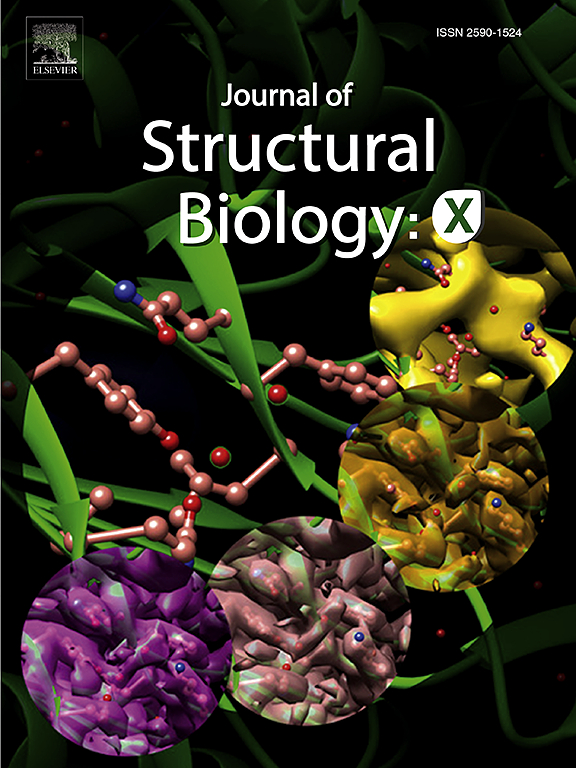Untangling the effects of flexibility and the AWI in cryoEM sample preparation: A case study using KtrA
IF 2.7
3区 生物学
Q3 BIOCHEMISTRY & MOLECULAR BIOLOGY
引用次数: 0
Abstract
Single particle cryo-electron microscopy (cryoEM) is a powerful tool for elucidating the structures of biological macromolecules without requiring crystallisation or fixation. However, certain barriers to obtaining high-resolution structures persist, particularly during grid preparation when samples are in a thin liquid film. At this stage, extensive exposure to the air–water interface (AWI) can lead to subunit dissociation, denaturation, and preferred orientation of particles. Another obstacle to high-resolution cryoEM is molecular flexibility, which introduces heterogeneity in the dataset, weakening the signal during image processing. This study explores the effects of AWI interactions and molecular flexibility on the cryoEM density maps of KtrA, the soluble regulatory subunit of the potassium transporter KtrAB from Bacillus subtilis. From grids prepared using a standard blotting technique, we observed a lack of density in the C-lobe domains and preferred orientation. Modifications such as reducing AWI exposure through faster vitrification times (6 s vs ≤100 ms) notably improved C-lobe density. Moreover, the addition of cyclic di-AMP, which binds to the C-lobes, combined with a 100 ms plunge time, further enhanced C-lobe density and eliminated preferred orientation. These findings demonstrate that both AWI interactions and flexibility had to be addressed to obtain density for the C-lobe domains of KtrA. This study underscores the ongoing complexities in achieving high-resolution cryoEM for many samples.

解开低温样品制备中灵活性和AWI的影响:使用KtrA的案例研究
单粒子低温电子显微镜(cryoEM)是一种无需结晶或固定就能阐明生物大分子结构的强大工具。然而,获得高分辨率结构的某些障碍仍然存在,特别是在样品处于薄液体膜中的网格制备过程中。在这个阶段,大量暴露于空气-水界面(AWI)会导致亚基解离、变性和颗粒的首选取向。高分辨率低温电子显微镜的另一个障碍是分子的灵活性,这在数据集中引入了异质性,在图像处理过程中削弱了信号。本研究探讨了AWI相互作用和分子柔韧性对枯草芽孢杆菌钾转运体KtrAB的可溶性调控亚基KtrA低温密度图的影响。从使用标准印迹技术制备的网格中,我们观察到c叶区域缺乏密度和首选方向。通过更快的玻璃化时间(6秒vs≤100毫秒)减少AWI暴露等改进措施显著提高了c瓣密度。此外,加入与c瓣结合的环状二磷酸腺苷(cyclic di-AMP),再加上100 ms的撞击时间,进一步增强了c瓣密度,消除了择优取向。这些发现表明,为了获得KtrA C-lobe结构域的密度,必须解决AWI的相互作用和灵活性。这项研究强调了在许多样品中实现高分辨率冷冻电镜的复杂性。
本文章由计算机程序翻译,如有差异,请以英文原文为准。
求助全文
约1分钟内获得全文
求助全文
来源期刊

Journal of structural biology
生物-生化与分子生物学
CiteScore
6.30
自引率
3.30%
发文量
88
审稿时长
65 days
期刊介绍:
Journal of Structural Biology (JSB) has an open access mirror journal, the Journal of Structural Biology: X (JSBX), sharing the same aims and scope, editorial team, submission system and rigorous peer review. Since both journals share the same editorial system, you may submit your manuscript via either journal homepage. You will be prompted during submission (and revision) to choose in which to publish your article. The editors and reviewers are not aware of the choice you made until the article has been published online. JSB and JSBX publish papers dealing with the structural analysis of living material at every level of organization by all methods that lead to an understanding of biological function in terms of molecular and supermolecular structure.
Techniques covered include:
• Light microscopy including confocal microscopy
• All types of electron microscopy
• X-ray diffraction
• Nuclear magnetic resonance
• Scanning force microscopy, scanning probe microscopy, and tunneling microscopy
• Digital image processing
• Computational insights into structure
 求助内容:
求助内容: 应助结果提醒方式:
应助结果提醒方式:


